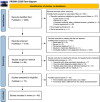Amyloid-β PET in Alzheimer's disease: A systematic review and Bayesian meta-analysis
- PMID: 36573329
- PMCID: PMC9847612
- DOI: 10.1002/brb3.2850
Amyloid-β PET in Alzheimer's disease: A systematic review and Bayesian meta-analysis
Abstract
Background: In recent years, longitudinal studies of Alzheimer's disease (AD) have been successively concluded. Our aim is to determine the efficacy of amyloid-β (Aβ) PET in diagnosing AD and early prediction of mild cognitive impairment (MCI) converting to AD. By pooling studies from different centers to explore in-depth whether diagnostic performance varies by population type, radiotracer type, and diagnostic approach, thus providing a more comprehensive theoretical basis for the subsequent widespread application of Aβ PET in the clinical setting.
Methods: Relevant studies were searched through PubMed. The pooled sensitivities, specificities, DOR, and the summary ROC curve were obtained based on a Bayesian random-effects model.
Results: Forty-eight studies, including 5967 patients, were included. Overall, the pooled sensitivity, specificity, DOR, and AUC of Aβ PET for diagnosing AD were 0.90, 0.80, 35.68, and 0.91, respectively. Subgroup analysis showed that Aβ PET had high sensitivity (0.91) and specificity (0.81) for differentiating AD from normal controls but very poor specificity (0.49) for determining AD from MCI. The pooled sensitivity and specificity were 0.84 and 0.62, respectively, for predicting the conversion of MCI to AD. The differences in diagnostic efficacy between visual assessment and quantitative analysis and between 11 C-PIB PET and 18 F-florbetapir PET were insignificant.
Conclusions: The overall performance of Aβ PET in diagnosing AD is favorable, but the differentiation between MCI and AD patients should consider that some MCI may be at risk of conversion to AD and may be misdiagnosed. A multimodal diagnostic approach and machine learning analysis may be effective in improving diagnostic accuracy.
Keywords: 11C-PIB; 18F-florbetapir; Alzheimer's disease; MCI converting to AD; amyloid-β PET.
© 2022 The Authors. Brain and Behavior published by Wiley Periodicals LLC.
Conflict of interest statement
The authors have no conflicts of interest to declare relevant to this article's content.
Figures






Similar articles
-
Predictive accuracy of amyloid imaging for progression from mild cognitive impairment to Alzheimer disease with different lengths of follow-up: a meta-analysis. [Corrected].Medicine (Baltimore). 2014 Dec;93(27):e150. doi: 10.1097/MD.0000000000000150. Medicine (Baltimore). 2014. PMID: 25501055 Free PMC article.
-
Longitudinal head-to-head comparison of 11C-PiB and 18F-florbetapir PET in a Phase 2/3 clinical trial of anti-amyloid-β monoclonal antibodies in dominantly inherited Alzheimer's disease.Eur J Nucl Med Mol Imaging. 2023 Jul;50(9):2669-2682. doi: 10.1007/s00259-023-06209-0. Epub 2023 Apr 5. Eur J Nucl Med Mol Imaging. 2023. PMID: 37017737 Free PMC article. Clinical Trial.
-
Elevated CSF GAP-43 in Mild Cognitive Impairment Linked to Cognitive Impairment Through Increased Amyloid-β Accumulation, with a Shift to Reduced Amyloid-β Accumulation in Alzheimer's Disease.J Mol Neurosci. 2025 Mar 20;75(2):39. doi: 10.1007/s12031-025-02333-8. J Mol Neurosci. 2025. PMID: 40111590
-
Signs and symptoms to determine if a patient presenting in primary care or hospital outpatient settings has COVID-19.Cochrane Database Syst Rev. 2022 May 20;5(5):CD013665. doi: 10.1002/14651858.CD013665.pub3. Cochrane Database Syst Rev. 2022. PMID: 35593186 Free PMC article.
-
Impact of diabetes on the progression of Alzheimer's disease via trajectories of amyloid-tau-neurodegeneration (ATN) biomarkers.J Nutr Health Aging. 2025 Feb;29(2):100444. doi: 10.1016/j.jnha.2024.100444. Epub 2024 Dec 10. J Nutr Health Aging. 2025. PMID: 39662155 Free PMC article.
Cited by
-
APOE genotype and sex modulate Alzheimer's disease pathology in aged EFAD transgenic mice.Front Aging Neurosci. 2023 Oct 31;15:1279343. doi: 10.3389/fnagi.2023.1279343. eCollection 2023. Front Aging Neurosci. 2023. PMID: 38020764 Free PMC article.
-
Predicting early Alzheimer's with blood biomarkers and clinical features.Sci Rep. 2024 Mar 13;14(1):6039. doi: 10.1038/s41598-024-56489-1. Sci Rep. 2024. PMID: 38472245 Free PMC article.
-
Expanding horizons in theragnostics: from oncology to multidisciplinary applications.Radiol Med. 2025 May;130(5):613-628. doi: 10.1007/s11547-025-01971-7. Epub 2025 Mar 5. Radiol Med. 2025. PMID: 40042756 Review.
-
Amyloid deposition and its association with depressive symptoms and cognitive functions in late-life depression: a longitudinal study using amyloid-β PET images and neuropsychological measurements.Alzheimers Res Ther. 2024 Oct 19;16(1):232. doi: 10.1186/s13195-024-01562-0. Alzheimers Res Ther. 2024. PMID: 39427221 Free PMC article.
-
Therapeutic Inhalation of Hydrogen Gas for Alzheimer's Disease Patients and Subsequent Long-Term Follow-Up as a Disease-Modifying Treatment: An Open Label Pilot Study.Pharmaceuticals (Basel). 2023 Mar 13;16(3):434. doi: 10.3390/ph16030434. Pharmaceuticals (Basel). 2023. PMID: 36986533 Free PMC article.
References
-
- Albert, M. S. , Dekosky, S. T. , Dickson, D. , Dubois, B. , Feldman, H. H. , Fox, N. C. , Gamst, A. , Holtzman, D. M. , Jagust, W. J. , Petersen, R. C. , Snyder, P. J. , Carrillo, M. C. , Thies, B. , & Phelps, C. H. (2011). The diagnosis of mild cognitive impairment due to Alzheimer's disease: Recommendations from the National Institute on Aging‐Alzheimer's Association workgroups on diagnostic guidelines for Alzheimer's disease. Alzheimer's & Dementia, 7(3), 270–279. 10.1016/j.jalz.2011.03.008 - DOI - PMC - PubMed
-
- Alvarez, I. , Aguilar, M. , Gonzalez, J. M. , Ysamat, M. , Lorenzo‐Bosquet, C. , Alonso, A. , Tartari, J. P. , Romero, S. , Diez‐Fairen, M. , Carcel, M. , Pujalte, F. , & Pastor, P. (2018). Clinic‐based validation of cerebrospinal fluid biomarkers with florbetapir PET for diagnosis of dementia. Journal of Alzheimer's Disease, 61(1), 135–143. 10.3233/JAD-170753 - DOI - PubMed
-
- Avgerinos, K. I. , Ferrucci, L. , & Kapogiannis, D. (2021). Effects of monoclonal antibodies against amyloid‐beta on clinical and biomarker outcomes and adverse event risks: A systematic review and meta‐analysis of phase III RCTs in Alzheimer's disease. Ageing Research Reviews, 68, 101339. 10.1016/j.arr.2021.101339 - DOI - PMC - PubMed
Publication types
MeSH terms
Substances
Grants and funding
LinkOut - more resources
Full Text Sources
Medical

